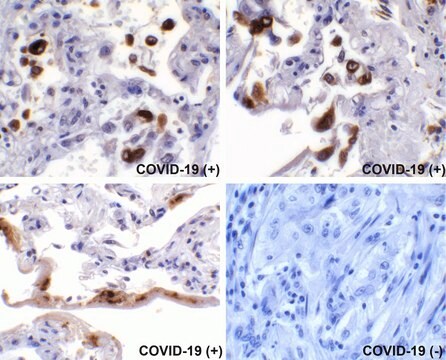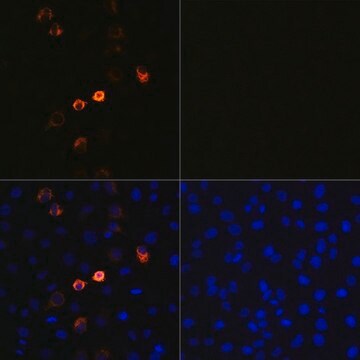SAB4200872
Anti-SARS-CoV-2-Spike protein C-terminal antibody produced in rabbit
affinity isolated antibody, buffered aqueous solution
Sinónimos:
ACE2-binding protein, Angiotensin Converting Enzyme 2 (ACE2)-binding region, COVID-19 Spike protein, Coronavirus, RBD Region, Severe acute respiratory syndrome coronavirus 2 (SARS-CoV2), Spike surface glycoprotein
About This Item
Productos recomendados
antibody form
affinity isolated antibody
Quality Level
antibody product type
primary antibodies
form
liquid
species reactivity
viral
concentration
~1 mg/mL
technique(s)
immunoblotting: 1:1000-1:2000 using SARS-CoV-2 Spike RBD (Cat. No. SAE1000) for coating.
indirect ELISA: 1/2000-1/4000 using 2 μg/mL SARS-CoV-2 Spike RBD (Cat. No. SAE1000) for coating.
UniProt accession no.
shipped in
dry ice
storage temp.
−20°C
target post-translational modification
unmodified
General description
Specificity
Immunogen
Application
Biochem/physiol Actions
Physical form
Storage and Stability
Disclaimer
Not finding the right product?
Try our Herramienta de selección de productos.
Storage Class
12 - Non Combustible Liquids
wgk_germany
WGK 1
Certificados de análisis (COA)
Busque Certificados de análisis (COA) introduciendo el número de lote del producto. Los números de lote se encuentran en la etiqueta del producto después de las palabras «Lot» o «Batch»
¿Ya tiene este producto?
Encuentre la documentación para los productos que ha comprado recientemente en la Biblioteca de documentos.
Artículos
Antibody fragmentation with our pepsin digestion protocol for IgG antibody fragmentation and preparation of F(ab’).
Nuestro equipo de científicos tiene experiencia en todas las áreas de investigación: Ciencias de la vida, Ciencia de los materiales, Síntesis química, Cromatografía, Analítica y muchas otras.
Póngase en contacto con el Servicio técnico








